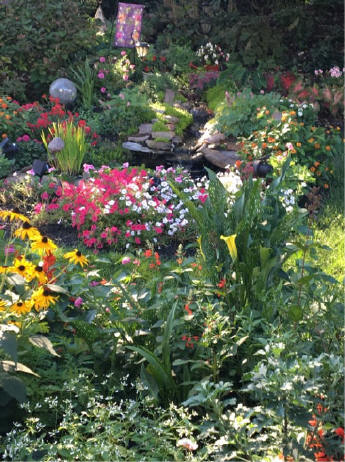
Annual plants, as the name implies, last one growing season and need to be replanted every year. Advantages to planting annuals are that they tend to bloom all season long and their blooms are usually bright and vivid. One of the greatest advantages of planting annuals is the wide selection of varieties, shapes, and colors. Annual bedding plants enable gardeners to experiment with new color combinations each year.
Perennials are plants that last more than two years. Perennials are great investments for the garden because they do not have to be replaced every year. Their bloom time is not as long as annuals, and they typically cost more than annuals.
Filling in with annuals is a great way to make a perennial garden look lush throughout the entire growing season. As empty areas appear in a perennial landscape, they can be planted with a wide variety of annuals or supplemented with containers of annuals. Annuals generally bloom more freely and over a longer period of time than perennials. Choose annuals that will complement the existing perennials. Having a variety of plants provides habitat for many different pollinators. Determine whether your location works best with low-growing annuals or with annuals having more height. Annual vines on trellises provide a nice vertical element to the garden. Don’t be afraid to move annuals and perennials to different locations to improve the landscape design or provide a better location for them to grow at their peak performance. The important thing to remember when planning a diversified garden is to read the plant labels to determine the proper location for your
plantings. Full sun is considered six to eight hours per day. Partial Sun is three to six hours of sun. Full shade is no more than three hours of sun a day.
 There are hundreds of annuals for your selection. Some are sown by seed directly into the garden, and some are planted indoors and transplanted at the appropriate time into the landscape. Some lovely flowers to grow from seed are sunflowers, marigolds, zinnias, nasturtiums, annual poppies, sweet alyssum, larkspur, and hyacinth beans. Remember to carefully follow the directions on the packets for planting requirements.
There are hundreds of annuals for your selection. Some are sown by seed directly into the garden, and some are planted indoors and transplanted at the appropriate time into the landscape. Some lovely flowers to grow from seed are sunflowers, marigolds, zinnias, nasturtiums, annual poppies, sweet alyssum, larkspur, and hyacinth beans. Remember to carefully follow the directions on the packets for planting requirements.
Annuals can also be purchased in market packs of 4, 6 or 8 plants. There are also specialty annuals, of many different and unusual varieties, which come in individual containers. Annuals can be selected for their color, shape and size. Some can be chosen for their foliage, such as coleus and sweet potato vine. It is best to go to a reputable garden center to purchase annuals. Look for healthy plants and avoid those with roots growing out of the bottom of the pots. Inspect the plants carefully. Yellow or diseased leaves are signs of problems. Choose plants that have some buds.
Most annuals should not be planted until there is no danger of frost. This date is typically May 15th. It is recommended to do a soil test prior to planting to determine if you need to add any amendments to the soil. A soil test kit can be purchased at your local County Extension Office.
The ideal time to plant annuals is on a cloudy day. This protects them from getting sun-stressed as they acclimate to their new environment. Another option is to plant them in the evening if this is when your schedule allows for gardening. Water any annuals that are dry before removing them from their cell packs or pots. Root balls should be moist at planting time. Never pull annuals from their containers. Instead, remove plants by gently squeezing the pot and then flipping it over, cradling the stems with your hand. They should then easily release from the container. Use a trowel to dig shallow holes large enough to cradle the root balls. Gently place the annuals in the holes and firmly place the soil around the plants. It is beneficial to add a slow-release fertilizer to the soil when planting. Give the annuals a good soaking of water after planting and add a layer of mulch to slow water evaporation from the soil.
Be vigilant about watering the annuals when the soil feels dry. It is best to water early in the day so that the plant’s foliage can dry off as the day warms up. They will also benefit from fertilizing and regularly deadheading the spent blooms as the growing season progresses.
In the summer months, some varieties of annuals may become straggly and spindly. Don’t be afraid to prune them to enhance their growth. Your annuals will naturally slow their flowering in late summer to early fall. Replace them with mums, violas, pansies, and flowering kale and cabbage until you can start a garden of fresh annuals next spring.
Annuals bring color and foliage to the garden with their non-stop, season-long, stunning splendor. They allow the adventuresome gardener to change the color scheme of the gardens every year. No other plant delivers the splashes of color that annuals provide to a garden landscape. In containers or planting beds, annuals will not disappoint gardeners.